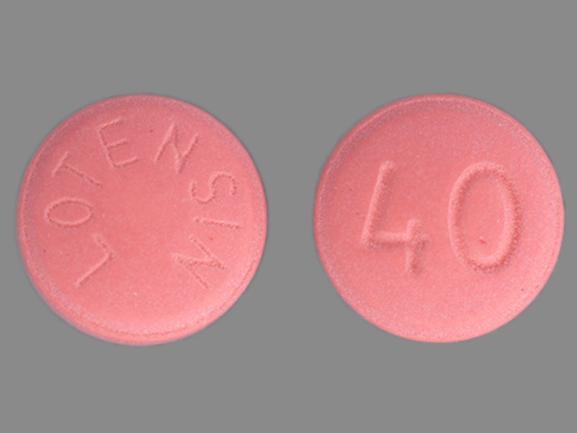Lotensin and Alcohol/Food Interactions
There are 2 alcohol/food/lifestyle interactions with Lotensin (benazepril).
Benazepril Alcohol (Ethanol)
Moderate Drug Interaction
MONITOR: Many psychotherapeutic and CNS-active agents (e.g., anxiolytics, sedatives, hypnotics, antidepressants, antipsychotics, opioids, alcohol, muscle relaxants) exhibit hypotensive effects, especially during initiation of therapy and dose escalation. Coadministration with antihypertensives and other hypotensive agents, in particular vasodilators and alpha-blockers, may result in additive effects on blood pressure and orthostasis.
MANAGEMENT: Caution and close monitoring for development of hypotension is advised during coadministration of these agents. Some authorities recommend avoiding alcohol in patients receiving vasodilating antihypertensive drugs. Patients should be advised to avoid rising abruptly from a sitting or recumbent position and to notify their physician if they experience dizziness, lightheadedness, syncope, orthostasis, or tachycardia. Patients should also avoid driving or operating hazardous machinery until they know how the medications affect them.
References (10)
- Sternbach H (1991) "Fluoxetine-associated potentiation of calcium-channel blockers." J Clin Psychopharmacol, 11, p. 390-1
- Shook TL, Kirshenbaum JM, Hundley RF, Shorey JM, Lamas GA (1984) "Ethanol intoxication complicating intravenous nitroglycerin therapy." Ann Intern Med, 101, p. 498-9
- Feder R (1991) "Bradycardia and syncope induced by fluoxetine." J Clin Psychiatry, 52, p. 139
- Ellison JM, Milofsky JE, Ely E (1990) "Fluoxetine-induced bradycardia and syncope in two patients." J Clin Psychiatry, 51, p. 385-6
- Rodriguez de la Torre B, Dreher J, Malevany I, et al. (2001) "Serum levels and cardiovascular effects of tricyclic antidepressants and selective serotonin reuptake inhibitors in depressed patients." Ther Drug Monit, 23, p. 435-40
- Cerner Multum, Inc. "Australian Product Information."
- Pacher P, Kecskemeti V (2004) "Cardiovascular side effects of new antidepressants and antipsychotics: new drugs, old concerns?" Curr Pharm Des, 10, p. 2463-75
- Andrews C, Pinner G (1998) "Postural hypotension induced by paroxetine." BMJ, 316, p. 595
- (2023) "Product Information. Buprenorphine (buprenorphine)." G.L. Pharma UK Ltd
- (2023) "Product Information. Temgesic (buprenorphine)." Reckitt Benckiser Pty Ltd
Benazepril Food/Lifestyle
Moderate Food Interaction
GENERALLY AVOID: Moderate-to-high dietary intake of potassium can cause hyperkalemia in some patients who are using angiotensin converting enzyme (ACE) inhibitors. In some cases, affected patients were using a potassium-rich salt substitute. ACE inhibitors can promote hyperkalemia through inhibition of the renin-aldosterone-angiotensin (RAA) system.
MANAGEMENT: It is recommended that patients who are taking ACE inhibitors be advised to avoid moderately high or high potassium dietary intake. Particular attention should be paid to the potassium content of salt substitutes.
References (3)
- (2002) "Product Information. Vasotec (enalapril)." Merck & Co., Inc
- Good CB, McDermott L (1995) "Diet and serum potassium in patients on ACE inhibitors." JAMA, 274, p. 538
- Ray K, Dorman S, Watson R (1999) "Severe hyperkalaemia due to the concomitant use of salt substitutes and ACE inhibitors in hypertension: a potentially life threatening interaction." J Hum Hypertens, 13, p. 717-20
Switch to consumer interaction data
Lotensin drug interactions
There are 394 drug interactions with Lotensin (benazepril).
Lotensin disease interactions
There are 7 disease interactions with Lotensin (benazepril) which include:
- angioedema
- bone marrow suppression
- hemodialysis
- hyperkalemia
- hypotension
- liver disease
- renal dysfunction
More about Lotensin (benazepril)
- Lotensin consumer information
- Check interactions
- Compare alternatives
- Reviews (5)
- Drug images
- Side effects
- Dosage information
- Patient tips
- During pregnancy
- Generic availability
- Drug class: Angiotensin Converting Enzyme Inhibitors
- Breastfeeding
- En español
Related treatment guides
Drug Interaction Classification
| Highly clinically significant. Avoid combinations; the risk of the interaction outweighs the benefit. | |
| Moderately clinically significant. Usually avoid combinations; use it only under special circumstances. | |
| Minimally clinically significant. Minimize risk; assess risk and consider an alternative drug, take steps to circumvent the interaction risk and/or institute a monitoring plan. | |
| No interaction information available. |
See also:
Further information
Always consult your healthcare provider to ensure the information displayed on this page applies to your personal circumstances.


